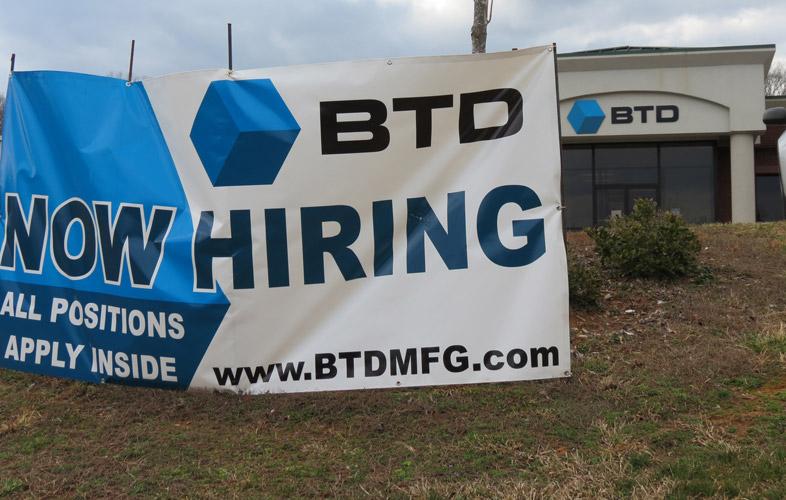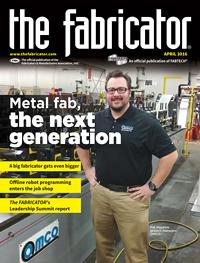Senior Editor
- FMA
- The Fabricator
- FABTECH
- Canadian Metalworking
Categories
- Additive Manufacturing
- Aluminum Welding
- Arc Welding
- Assembly and Joining
- Automation and Robotics
- Bending and Forming
- Consumables
- Cutting and Weld Prep
- Electric Vehicles
- En Español
- Finishing
- Hydroforming
- Laser Cutting
- Laser Welding
- Machining
- Manufacturing Software
- Materials Handling
- Metals/Materials
- Oxyfuel Cutting
- Plasma Cutting
- Power Tools
- Punching and Other Holemaking
- Roll Forming
- Safety
- Sawing
- Shearing
- Shop Management
- Testing and Measuring
- Tube and Pipe Fabrication
- Tube and Pipe Production
- Waterjet Cutting
Industry Directory
Webcasts
Podcasts
FAB 40
Advertise
Subscribe
Account Login
Search
Big-league metal fabrication
The story behind BTD’s strategic acquisition of Impulse Manufacturing
- By Tim Heston
- April 13, 2016
- Article
- Shop Management
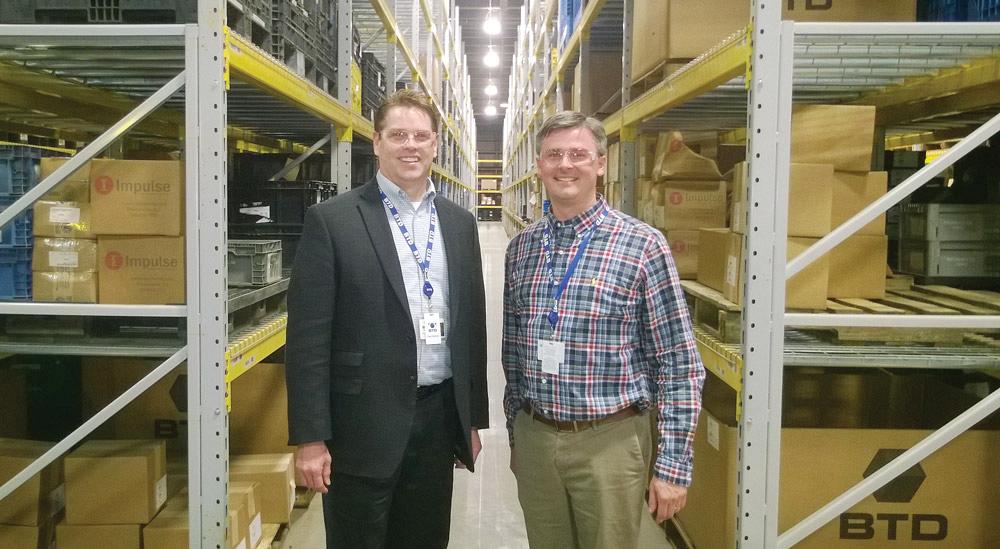
Figure 1
Paul Gintner, president of BTD (on the left), and Karl Baysden, director of sales, stand by the company’s racks holding strategic amounts of inventory.
By 2015 Impulse Manufacturing was breaking revenue records. The Dawsonville, Ga.-based custom fabricator had a little more than $31 million in sales in 2013; two years later it had turned into a $60 million enterprise with 400 employees and three locations.
The fabricator had invested in plenty of new equipment: a second tube laser; stamping presses; two large-work-envelope robot welding cells; and, most significant, a $7 million painting line that includes an Autophoretic® coating (a dip process like e-coat, but chemical instead of electrical) along with a powder topcoat.
Last year, though, the family-owned company had reached a turning point. Impulse’s president and founder was ready to retire, and his family started talking: Where did they see the company in five or 10 years? Could it continue to serve its current customers while taking on even larger contracts? Or was it time to sell the business? What path would best serve both employees and customers?
The family ultimately chose the latter path and, after considering multiple options, sold the business to Detroit Lakes, Minn.-based BTD, one of the largest custom metal fabricators in the country.
Challenges of Scaling Up
Every June this magazine publishes the FAB 40, a list of some of the largest custom metal fabricators, and through 2015 both BTD and Impulse appeared on this list.
The FAB 40 has a distinct pattern. As you move up the list, gaps in revenue between companies increase. In 2015, starting at No. 20, less than $1 million separated one fabricator’s revenue from the next. At the top of the list, almost $50 million separated Nos. 1 and 2, and almost $100 million separated Nos. 2 and 3. The revenue distribution has a sharp peak representing a few large companies followed by a long tail of smaller ones.
This doesn’t surprise Karl Baysden (see Figure 1). Son of Impulse’s founder Ron Baysden and now director of sales at BTD, he remembers the conversations with his family last year. The company had grown to the point where it was just starting to compete with some of the largest contract fabricators in the country.
To get to the next level, Baysden said that Impulse would have required an immense amount of capital. The fabricator was no stranger to spending, of course. It had, after all, just purchased a $7 million coating system (see Figure 2). The company was (and still is) one of the few if not the only contract manufacturer in the Southeast to have such an extensive Autophoretic system, offering complete part coverage and solid corrosion protection. This certainly put Impulse in a good competitive position. But to grow dramatically—and to climb the “steep head” of the FAB 40, so to speak—required something more.
To reduce the cost of managing their supply chains, large OEMs have been parsing their supplier base, focusing on a few partner suppliers rather than a large collection of small shops. This strategy comes with its own risks, though.
What if one of those large contract shops becomes dependent on a handful of large customers and goes belly up when one large account goes south? Or maybe its plant gets hit by a tornado, hurricane, or flood. What then? For this reason, custom fabricators with solid financials (having diverse revenue streams) and multiple plants have become more important than ever. And if those plants are spread over a wide geographic area and so are able to service customers in multiple locations, that’s even better.

Figure 2
Before being acquired, Impulse installed an extensive Autophoretic coating system (a dip process like e-coat, though the reaction is chemical instead of electric) with a powder topcoat. Here, parts emerge from the drying oven overhead.
A Growing Footprint
In recent years BTD could have easily been victim to market downturns in agriculture and mining. But its revenue stream is highly diversified, and large customers in the recreation sector, lawn and garden, and elsewhere have helped it keep revenue levels steady through tumultuous times. BTD reported revenues of $180 million in 2015, down less than 5 percent from 2014.
In 2014 BTD had four locations in Minnesota and another location in Illinois, but none in the Southeast, which was why it was a little surprising to see the fabricator exhibiting at FABTECH® in Atlanta that year. In BTD’s booth was Vice President of Sales Jared Lotzer, who made the fabricator’s intentions clear: Company leaders were looking to expand BTD’s footprint, either organically or through acquisition.
During his visit to the Georgia plant earlier this year, Paul Gintner, BTD’s president, put that strategy in perspective. “Back in 2012 we started putting a strategy in place. We studied the markets we were serving in the Midwest. If we were looking for a logical place to grow some of those same end markets—lawn and garden, recreational vehicle, agriculture, construction—all of it was here in the Southeast.”
In 2012 BTD launched a new sales effort. The sales team communicated its expansion plans to key customers. The team also sold BTD as not just a regional supplier, but one that could service much of the country. BTD plants in Minnesota and Illinois started delivering products not only throughout the Midwest, but also to OEM assembly plants in the Southeast.
Originally, BTD had planned to open a physical location in the Southeast by 2017. But when a large recreation and military vehicle customer opened an assembly plant in Alabama last year, BTD’s plans accelerated. It was time to expand southward.
The Evolution of Impulse
In early 2008 workers at Impulse probably couldn’t imagine the dramatic shifts in business that lie ahead. At the time the fabricator was experiencing record revenues. Then came the fourth quarter, when orders slowed to a trickle.
“In 2009 orders slowed significantly, and we adjusted our business model to match, resulting in an intense focus on lean manufacturing. We reduced our planned equipment investment and refocused almost exclusively on efficiency, reduced setup costs and increased throughput. Our goal was to get as lean and efficient as possible,” Baysden said. “We developed a lot of robust custom software tracking systems during that time.”
This included a new focus on overall equipment effectiveness (OEE) and utilizing machine uptime monitors, including ShopFloorConnect® from Wintriss Controls, modifying the tracking mechanisms to suit the shop’s product mix. They measured everything, not just the job cycle time but also (and perhaps most important) the time between jobs—that is, the time from the last good part of the previous job to the first good part of the next job.
“We began tracking weld arc-on time. We began counting the seconds between strokes on press brakes,” Baysden said.
Employees focused on quick changeovers too. In the welding area, for instance, they systematically inspected and staged fixtures ahead of what they called “welding lanes.” Fixtured assemblies entered one side and weldments exited the other side (see Figure 3). They implemented arc-on-time monitoring to identify and free hidden part flow constraints.
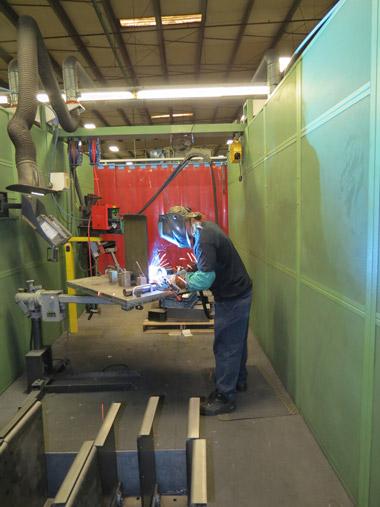
Figure 3
A welder works in a “welding lane,” with fixtured parts staged on the far end and welded parts at the other end, ready to be moved to the next process.
They standardized quality to meet their most stringent customer’s demand, performing production part approval processes (PPAPs) whether a customer asked for it or not. They built a customized system on top of their JobBOSS enterprise resource planning (ERP). The company put systems in place that helped disseminate any part design change information immediately. And it implemented periodic process audits (dubbed the Impulse Manufacturing Methodology Audit) to ensure documented procedures were being followed.
All this set the stage for revenue growth and serious capital spending. “We really exploded when the economy turned around,” Baysden recalled. “We were buying equipment as fast as we could. And we standardized our equipment by purchasing the same brand, and same model in most cases.”
The company doesn’t have a single brand of machine tool throughout its shop. But it does buy the same brands of machine tools in specific departments: Safan in the press brake area (see Figure 4); BLM for laser tube cutting and bending; MC Machinery Systems for laser cutting; Prima Power for automated shearing and punching.
The revenue growth introduced Impulse to new, larger customers. “Our customer base grew rapidly. It changed from smaller companies to FORTUNE 500 companies,” Baysden said. “Larger OEM organizations began contacting us, and our customer base really began to transition in 2010.”
These customers were wanting mpulse to provide services that it couldn’t serve from the Dawsonville facility, and many of these large companies had locations throughout the Southeast. “So we decided from a strategic perspective that we wanted to expand geographically [and] have locations in the Carolinas,” Baysden said.
This led to acquisitions. In 2014 Impulse purchased two machine shops, Mid-State Manufacturing in Mount Ulla, N.C., and Bellwright Manufacturing in Summerville, S.C., which served the automotive and general industrial OEM markets. This gave Impulse not only more locations in the Southeast, but also additional machining capacity. Before Impulse had a handful of machining centers in Dawsonville; after the acquisitions, it had more than 50.
Still, the growth wasn’t all smooth sailing. In January 2015, a four-alarm fire destroyed Impulse’s newly acquired Mount Ulla shop. No one was hurt, but nearly all the physical assets, including many machining centers, were burned beyond repair. (Incidentally, BTD already has extensive machining offerings, so the Summerville machine shop Impulse purchased two years ago remains an Impulse company today.)
In 2008 Impulse was a big fish in a medium-sized pond. But by 2015 it was a larger fish, but now swimming in a much larger body of water—with much bigger fish.
“Customers were challenging us with more complex product awards that required additional capital—new lasers, new robots, new million-dollar machining centers,” Baysden said. “There was an entirely new capital requirement.”
Birth of BTD Georgia
In 2015 the M&A stars aligned, it seemed. One of BTD’s big customers opened a plant in Alabama, and BTD started getting serious about expanding in the Southeast.
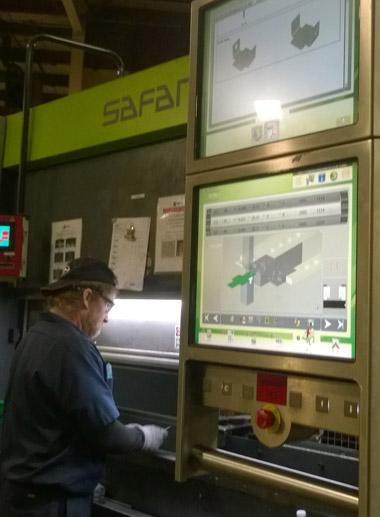
Figure 4
Every new press brake at BTD Georgia (all of them electric) was customized with two monitors so that operators can see multiple aspects of the job at once. Here, the bottom screen shows a simulation of the bend sequence while the top screen shows a 3-D model of the piece being formed.
“We knew Impulse was a large player in the local market,” Gintner said. “And it just so happened that it came up for sale. It was pure luck. We [the managers at both companies] got together, and we really understood each other. All of us grew up on the shop floor.” (Gintner started at BTD in the 1980s in the tool and die department.) “We hit it off right away.”
Impulse had a customer base that complemented BTD’s, diversifying the revenue stream even further. And it had significant painting capacity, which is common for many fab shops in the Southeast, but not as common for shops in the Midwest that have access to many nearby custom coaters. (BTD’s facilities in the Midwest didn’t have in-house powder coating until last year.)
In September 2015 BTD purchased Impulse’s operations in Dawsonville, and workers are seeing significant changes. In the coming months, for instance, the Dawsonville plant will have several coil-fed stamping presses to handle some of the higher-volume work expected from the recreational vehicle and lawn and garden sectors.
More than new machinery, though, changes involve the integration of Dawnsonville into a larger whole. Still, sources emphasized that this wasn’t a bolt-on acquisition, with people and machines being “bolted on” to the purchasing organization with no regard for pre-existing procedures. This isn’t to say bolt-ons aren’t smart business moves sometimes, but according to sources at BTD, it wouldn’t have been a good move in this case.
For one, Impulse and BTD share similar cultures. Both measure processes down to minutiae, and both have highly documented procedures. Their ISO certifications were more than just a piece of paper.
After the purchase, BTD managers interviewed every employee at the Georgia plant individually. “We really needed to know the skill sets, and we wanted to know the culture and what people really thought about the company they worked for,” Gintner said.
Both companies also made good use of information technology and operational transparency. Impulse built a highly customized web interface on top of their existing ERP, and BTD uses a highly customized system based on Microsoft’s Dynamics AX. And at this writing, the Dawsonville facility is moving toward adopting BTD’s system (see Figure 5).
“We created an MES [manufacturing execution system] that’s bolted on to our ERP system,” Gintner explained. “On the shop floor, everything from work instructions and control plans to prints is accessible at every workstation. It’s actually similar to what they [Impulse] already have.”
BTD isn’t just assimilating Impulse into the “BTD way,” either. The sharing of best practices goes both ways. “So often the ‘big company’ offers ideas to the ‘little company,’” Gintner said. “There are a lot of good ideas they’ve created here, like how to track, how to measure. My operations people from Minnesota are here in Georgia working hand-in-hand.”
In one sense, BTD looks a lot like Impulse might look like if it had added a few zeros to its annual sales volume. As Gintner recalled, “Initially, when we walked through the plant, it just had a feel of BTD.”

Figure 5
Racks, installed at the Dawsonville plant in early 2016, show a transition to BTD’s inventory management philosophy.
New Inventory Strategy
The biggest change is in finished-goods inventory; before the purchase, the Dawsonville plant didn’t have much of it. “The BTD model is that we build to stock, and customers pull from inventory,” Gintner said, adding that the build-to-order model can work if parts remain somewhat simpler. But as parts become more complex, complications arise, and even the tiniest hiccup in the schedule can lead to a late delivery.
“What they [Impulse] did was great, especially from a cash flow perspective,” Gintner continued. “But we just feel we can grow the business more with an inventory buffer. We really use inventory as a capacity tool.” He added that without it, the company would need more equipment and people to service the customer, especially during periods of peak demand.
At many locations, BTD maintains an on-time delivery (OTD) rate higher than 97 percent. That near-perfect delivery occurs in an organization that processes thousands of complicated assemblies.
Gintner pointed to one of those assembles in the front lobby of the Dawsonville plant, one with an exhaust duct having hundreds of plates welded at just the right angle to maintain a specific airflow. If a part requires, say, just laser cutting and a few bends, BTD would have no reason to build that part to stock. But when the shop is managing ever-more-complex assemblies, “you just can’t react to that in a day and produce on demand,” Gintner said.
And there’s no getting around the fact that large OEMs have highly variable demand. If demand spikes unexpectedly, OEMs want to be able to pull more products from a supplier’s inventory—and BTD is capable of offering that service.
It does this through careful planning and forecasting based on historical demand and design stability (that is, how frequently a part design may be changed in some way). The company also bar codes everything and tracks revision changes to ensure old versions don’t get mixed up with current (correct) part designs.
“People often don’t think a job shop or contract manufacturer can manage SKUs in the thousands,” Gintner said. “And yes, it is difficult. People thought we were crazy when we thought we could grow the company as big as it is. But if you sit down and have a plan for every part—where you want to inventory it, and how much, and when—you can do it.
“And it may not be in finished-goods inventory. It may need to be a child part [which once triggered by an order will go into a larger assembly]. And we still do quick-turn parts with returnable containers. But you need to scrutinize it. Where are you going to put those containers when not in use? Is it taking up valuable floor space?”
Gintner added that BTD wouldn’t be as successful as it is if it just built up stock without a plan. “The discipline has to be there. Again, it goes back to having a plan for every part.”
Shifting loads across plants also helps the OTD metric. The plant in Georgia may be the most logical place from which to ship a product to Alabama, but if capacity is an issue, BTD can shift that work to another plant that has identical fabrication, painting, and assembly capabilities. The customer should receive quality products on time; whether it comes from Georgia or Minnesota should make no difference.

Figure 6
A horizontal machining center with a large work envelope sits next to the company’s band saw. For many jobs, parts emerge from the saw and are then transferred immediately to the HMC.
Since it was acquired last year, the Dawsonville plant’s OTD rate has increased. Before the acquisition it was between 85 and 89 percent, which is near the industry average, according to the annual “Financial Ratios & Operational Benchmarking Survey” from the Fabricators & Manufacturers Association International®. Today the OTD rate in Dawsonville is in the mid-90s, and it’s getting higher. This is largely thanks to some new racking that holds finished-goods inventory.
Machining Strategy
Another big change is in machining. Previously Impulse maintained a machining department for tooling, fixtures, and parts needed to support its primary fabrication operation.
Today the machining centers are no longer in a department but are instead dispersed throughout the shop. That’s because now tooling and fixtures are made at BTD locations in Illinois and Minnesota that together employ more than 100 tool and die experts. The tooling is then shipped to Dawsonville’s tool and die department, where workers perform final inspections and make adjustments as needed.
Meanwhile, those other machining centers are now placed where needed to mill and turn components for fabrication jobs. For instance, the company placed a horizontal CNC mill next to a tube cutting operation (see Figure 6). Tubes emerge from the saw and then are fixtured on the mill for final machining. (It’s a simple straight cut and doesn’t require complicated contours, which is why it isn’t placed near one of the facility’s two tube lasers.)
Part of Something Big
The Dawsonville operation has undergone big changes not only in inventory and planning, but also in accounting. BTD is one of the few public custom fabricators. It’s owned by Otter Tail (OTTR on the NASDAQ), a $780 million organization that also operates public utilities.
The Georgia plant gives BTD a broad geographic footprint, spanning diagonally from Minnesota to the Deep South. By selling to BTD, Impulse effectively found a shortcut to scaling up—and the plant is hiring (see Figure 7). What was a medium-sized operation now competes in the big leagues, alongside some of the largest custom fabricators in the U.S.
BTD Manufacturing, 866-562-3986, www.btdmfg.com
About the Author

Tim Heston
2135 Point Blvd
Elgin, IL 60123
815-381-1314
Tim Heston, The Fabricator's senior editor, has covered the metal fabrication industry since 1998, starting his career at the American Welding Society's Welding Journal. Since then he has covered the full range of metal fabrication processes, from stamping, bending, and cutting to grinding and polishing. He joined The Fabricator's staff in October 2007.
Related Companies
subscribe now

The Fabricator is North America's leading magazine for the metal forming and fabricating industry. The magazine delivers the news, technical articles, and case histories that enable fabricators to do their jobs more efficiently. The Fabricator has served the industry since 1970.
start your free subscription- Stay connected from anywhere

Easily access valuable industry resources now with full access to the digital edition of The Fabricator.

Easily access valuable industry resources now with full access to the digital edition of The Welder.

Easily access valuable industry resources now with full access to the digital edition of The Tube and Pipe Journal.
- Podcasting
- Podcast:
- The Fabricator Podcast
- Published:
- 04/16/2024
- Running Time:
- 63:29
In this episode of The Fabricator Podcast, Caleb Chamberlain, co-founder and CEO of OSH Cut, discusses his company’s...
- Trending Articles
AI, machine learning, and the future of metal fabrication

Employee ownership: The best way to ensure engagement

Steel industry reacts to Nucor’s new weekly published HRC price

How to set a press brake backgauge manually

Capturing, recording equipment inspection data for FMEA

- Industry Events
16th Annual Safety Conference
- April 30 - May 1, 2024
- Elgin,
Pipe and Tube Conference
- May 21 - 22, 2024
- Omaha, NE
World-Class Roll Forming Workshop
- June 5 - 6, 2024
- Louisville, KY
Advanced Laser Application Workshop
- June 25 - 27, 2024
- Novi, MI
























